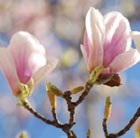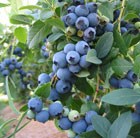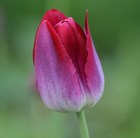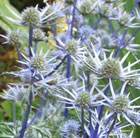New products at Crocus
by Sarah - August 28th, 2009.Filed under: Crocus, New Products.
New products today at Crocus

magnolia £39.99
Position: full sun or partial shadeSoil: moist, well-drained, acidic soilRate of growth: averageFlowering period: April to MayHardiness: fully hardyOne of the most popular magnolias, with large, dark green leaves that start to appear in mid spring, at about the same time as the huge, deep rose-pink or white, goblet-shaped flowers. This is a good magnolia for smaller gardens,as it remains a shapely shrub for many years, and even when it is mature, is a manageable small tree.Garden care: Requires minimal pruning. Remove any broken, diseased or crossing branches after flowering. The best time to plant is in April, adding plenty of peat to the planting hole, in a sheltered spot. Mulch in spring with manure and leafmould, especially on dry soils.Goes well with: Cornus alba 'Siberica', Corylus avellana 'Contorta', Rubus thibetanus, Daphne bholua 'Jacqueline Postill', Sarcococca hookeriana var. digyna, Galanthus elwesii, Muscari aucheri

blueberry – early fruiting £9.99
Position: full sun or partial shadeSoil: prefers moist, well-drained acidic soil but will grow in sandy or normal soilRate of growth: fast-growingOther features: light blue berries (June-July)Hardiness: fully hardyAn early season variety, which produces its delicious fruit on compact, rounded bushes. In late spring the plant is covered with masses of white flowers, and these are followed by firm, flavourful blueberries. These fruits appear in large clusters, so are very easy to pick. Beacause it produces so much fruit, commercial growers have nicknamed it 'the mortgage lifter'. Plant breeders have called it 'Bluegold', which probably refers to the blue berries and golden-yellow, winter wood.Garden care: Prepare the ground well before planting. Blueberries can also be grown in large pots and containers if ericaceous compost is used. Prune in winter, cutting out dead or damaged branches. In spring, feed with sulphate of ammonia, sulphate of potash and bonemeal and top-dress with ericaceous compost.

blueberry – late fruiting £9.99
Position: full sun or partial shadeSoil: prefers moist, well-drained acidic soil but will grow in sandy or normal soilRate of growth: fast-growingOther features: light blue berries (July-August)Hardiness: fully hardyA late season, highbush cultivar with large, light blue berries with an exceptional flavour. It is the perfect cultivar if you want to extend your blueberry harvest by an extra month. The fruits are produced in abundance on an upright bush, and are followed by white, sometimes pink tinged flowers. It is fully hardy, but will still do really well in warmer areas.Garden care: Prepare the ground well before planting. Blueberries can also be grown in large pots and containers if ericaceous compost is used. Prune in winter, cutting out dead or damaged branches. In spring, feed with sulphate of ammonia, sulphate of potash and bonemeal and top-dress with ericaceous compost.

sea holly £7.99
Position: full sunSoil: moist, well-drained soilRate of growth: average Flowering period: August to October Flower colour: steely blueOther features: superb foliageHardiness: fully hardyThis delightful Sea Holly has long lasting, bright metallic-blue flowers that arrive in mid to late summer and usually last well into the autumn. They have a strong architectural shape, so are best in uncrowded borders where they can really stand out on their own. Honey bees love their flowers so they are a perfect for adding to a sunny, wildlife-friendly garden.Garden care: Lift and divide large colonies in spring. Avoid the temptation to cut back the flowerheads in autumn as they provide interest in the winter garden.

hebe £7.99
Position: full sun or partial shadeSoil: poor or moderately fertile, moist, well-drained neutral to slightly alkaline soilRate of growth: averageFlowering period: July-OctoberHardiness: frost hardy (needs winter protection in cold areas)Deep purple flowers appear on short spikes from midsummer to late autumn, among masses of dark green, lance shaped leaves with red margins. Long-flowering, tough and easy to grow, this spreading, rounded, evergreen shrub will flourish in a wide range of conditions, and once established, is drought-tolerant, too. Plant it en masse along a fence or path, or to add structure to a mixed, sunny border, and underplant it with contrasting, drought-tolerant foliage plants such as Bergenia. The flowers are a magnet for bees and butterflies.Garden care: Needs minimal pruning. Remove misplaced or frost damaged branches in late spring.

triumph tulip £6.99
Position: full sunSoil: fertile, well-drained soilRate of growth: averageFlowering period: April – MayFlower colour: rich pinky redOther features: excellent cut-flowersHardiness: fully hardyBulb Size: 10/11The richly coloured petals of this beautiful tulip are flushed with a smokey haze on the outside, which gives the flowers a lustrous and rich feel. Like all triumph tulips, its sturdy stems stand up to the worst weather, and the flowers last well after being cut. A real beauty which is very tough and robust.Garden care: In September to December plant bulbs 15-20cm deep and 10-15cm apart in fertile, well-drained soil. Alternatively, allow 7-9 bulbs per 30cm sq. After flowering dead-head and apply a balanced liquid fertiliser each week for the first month. Once the foliage has died down naturally lift the bulbs and store in a cool greenhouse.

sea holly £6.49
Position: full sunSoil: dry, well-drained, poor to moderately fertile soilRate of growth: average Flowering period: July and AugustHardiness: fully hardyEasily recognised by their ruff of spiky bracts surrounding a prominent, cone-like centre of tiny flowers, sea hollies make a bold statement in a sunny border or gravel garden. This variety produces deeply cut, blue or grey-green bracts 6cm across on stiff green stems in July and August. The attractive, dark green, marbled foliage, which appears before the flowers, is shown off to best effect planted in gravel. Or try it in bold clumps among grasses. Eryngiums are also perfect for use in dried flower arrangements.Garden care: Lift and divide large colonies in spring. Avoid the temptation to cut back the flower-heads in autumn as they provide interest in the winter garden.






